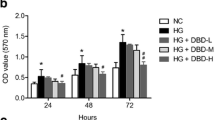Abstract
Diabetes mellitus is an endocrine and metabolic disease characterized by high blood glucose. Diabetic nephropathy (DN) is one of the most typical diabetic complications. Cornus officinalis is a type of traditional Chinese medicine that replenishes the liver and kidney. Morroniside is one of the main characteristic components of C. officinalis. In this study, an in vitro model for simulating DN damage was established by stimulating rat glomerular mesangial cells by the advanced glycation end products. The protective mechanism and effect of morroniside in regulating receptor for advanced glycation end products signaling pathway in DN was investigated to provide experimental evidence for the prevention and treatment of DN.





Similar content being viewed by others
References
Zhang X, Chen M. Discussion on mechanism of diabetic vasculopathy. Sichuan J Physiol Sci. 2008;30:172–4.
System USRD. USRDS2002 Annual Data Report. Bethesda: National Institutes of Health; 2002.
Wang N. Secondary renal disease. 6th ed. Shanghai: Science and Technology Literature Press; 2006.
Lehmann R, Schleicher E. Molecular mechanism of diabetic nephropathy. Clin Chim Acta. 2000;297:34–8.
Hu C, Sun L, Xiao L, et al. Insights into the mechanisms involved in the expression and regulation of extracellular matrix proteins in diabetic nephropathy. Curr Med Chem. 2015;22:2858–70.
Hong L, Li J, Gao L, et al. Effects of human glomerular mesangial cells cultured in high glucose on the expressions of TGF-β, FN and Smad7. Mag Microcirc. 2011;21:13–5.
Taguchi A, Blood D, del Toro G, et al. Blockade of RAGE–amphoterin signalling suppresses tumour growth and metastases. Nature. 2000;405:354–60.
Riehl A, Nemeth J, Angel P, Hess J. The receptor RAGE: bridging inflammation and cancer. Cell Commun Signal. 2009;7:12.
Wu R, Duan L, Cui F, et al. S100A9 promotes human hepatocellular carcinoma cell growth and invasion through RAGE-mediated ERK1/2 and p38 MAPK pathways. Exp Cell Res. 2015;334:228–38.
Cheng M, Liu H, Zhang D, et al. HMGB1 enhances the AGE-induced expression of CTGF and TGF-beta via RAGE-dependent signaling in renal tubular epithelial cells. Am J Nephrol. 2015;41:257–66.
Jin X, Yao T, Zhou Z, et al. Advanced glycation end products enhance macrophages polarization into M1 phenotype through activating RAGE/NF-kappa B pathway. Biomed Res Int. 2015;2015:732450.
Lv X, Xu H, Liu B, et al. Protective effect of morroniside on advanced glycation end products aggravating streptozotocin induced diabetes and its mechanism. Chin Herb Med. 2014;21:3109–16.
Yu Y, Ren W, Ren B. Nanosize titanium dioxide cause neuronal apoptosis: a potential linkage between nanoparticle exposure and neural disorder. Neurol Res. 2008;30:1115–20.
Yu Y, Zhang C. The role of connexin 43 in mediating odor response. Eur J Cell Biol. 2015;94:267–75.
Abdel-Rahman E, Bolton W. Pimagedine: a novel therapy for diabetic nephropathy. Expert Opin Inv Drug. 2002;11:565–74.
Hong D, Lee G, Jung NC, Jeon M. Fast automated yeast cell counting algorithm using bright-field and fluorescence microscopic images. Biol Proced Online. 2013;15:13.
Wang Y, Zhang Z, Chen X, Wang X, Cao H, Liu S. Advanced glycation end products promote human aortic smooth muscle cell calcification in vitro via activating NF-κB and down-regulating IGF1R expression. Acta Pharmacol Sin. 2013;34:480–6.
Yamamoto Y, Kato I, Doi T, et al. Development and prevention of advanced diabetic nephropathy in RAGE-overexpressing mice. J Clin Invest. 2001;108:261–8.
Myint K, Yamamoto Y, Doya T, et al. RAGE control of diabetic nephropathy in a mouse model: effects of RAGE gene disruption and administration of low-molecular weight heparin. Diabetes. 2006;55:2510–22.
Wang Q, Tong J, Du J, et al. Study on TGF-β1 regulating fibronectin secreted by mesangial cells through p38MAPK signal pathway. J China Med Univ. 2006;35:246–8.
Ma W, Wang KJ, Cheng CS, et al. Bioactive compounds from Cornus officinalis fruits and their effects on diabetic nephropathy. J Ethnopharmacol. 2014;153:840–5.
Park C, Noh J, Tanaka T, Yokozawa T. Effects of morroniside isolated from Corni Fructus on renal lipids and inflammation in type 2 diabetic mice. J Pharm Pharmacol. 2010;62:374–80.
Cheng L, Zeng G, Liu Z, et al. Protein kinase B and extracellular signal-regulated kinase contribute to the chondroprotective effect of morroniside on osteoarthritis chondrocytes. J Cell Mol Med. 2015;19:1877–86.
Yokozawa T, Yamabe N, Kim H, et al. Protective effects of morroniside isolated from Corni fructus against renal damage in streptozotocin-induced diabetic rats. Biol Pharm Bull. 2008;31:1422–8.
Acknowledgments
This work is supported by the National Natural Science Fund of China (No. 81073111), and Project Supported by the Discipline Construction Project of Jiangsu Colleges and Universities (No. Nzyzyxjg-1006).
Author information
Authors and Affiliations
Corresponding author
Ethics declarations
Conflict of interest
The authors declare that they have no conflict of interest.
Additional information
G. Lv and X. Lv contributed equally.
Rights and permissions
About this article
Cite this article
Lv, G., Lv, X., Tao, Y. et al. Effect of morroniside on glomerular mesangial cells through AGE–RAGE pathway. Human Cell 29, 148–154 (2016). https://doi.org/10.1007/s13577-015-0128-0
Received:
Accepted:
Published:
Issue Date:
DOI: https://doi.org/10.1007/s13577-015-0128-0




